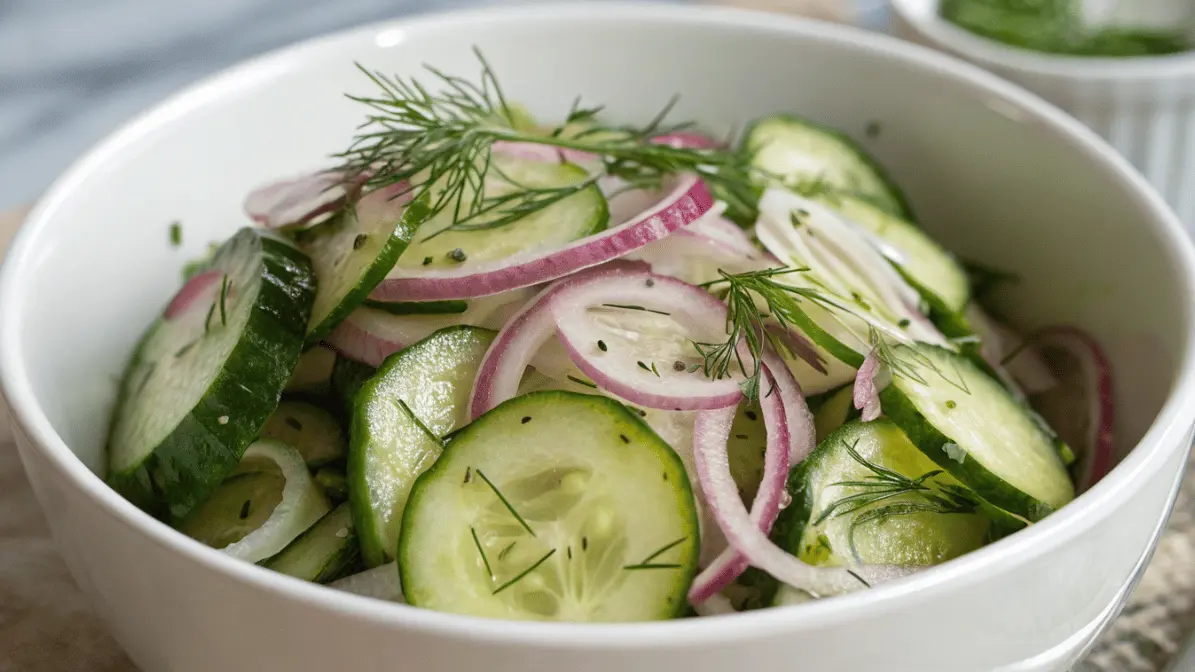Cucumber salad is one of those timeless dishes that delivers on every front—refreshing, easy to make, incredibly versatile, and packed with health benefits. Whether you’re preparing a light lunch, a quick side dish, or a vibrant addition to your summer barbecue, cucumber salad brings a cool crunch that few other recipes can match. This article will explore everything you need to know about this crisp classic, from secret ingredients and preparation methods to global variations like Greek cucumber salad and flavor combinations to avoid.
Discover great ideas like this one from our guide on simple raw vegan recipes—a perfect complement to cucumber-based meals.
Let’s dive into the world of cucumber salads, starting with why this humble dish continues to win hearts around the world.
Table of Contents
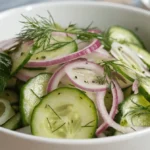
Cucumber Salad
- Total Time: PT10M
- Yield: 4 servings
- Diet: Low Calorie
Description
Cucumber Salad made easy with fresh, healthy ingredients and bold flavors. Discover the best tips, styles & secret ingredients.
Ingredients
– 2 English cucumbers, thinly sliced,
– 1/4 red onion, thinly sliced,
– 2 tbsp rice vinegar or apple cider vinegar,
– 1 tbsp sugar (optional),
– Salt to taste,
– 2 tbsp fresh chopped dill,
– 1 tbsp olive oil,
– Cracked black pepper to taste,
Instructions
> Salt the sliced cucumbers lightly and let them sit in a colander for 10 minutes to drain excess moisture. Pat dry with paper towels.
> In a bowl, whisk together rice vinegar (or apple cider vinegar), sugar (if using), olive oil, and black pepper.
> cucumbers, red onion, and fresh dill to the bowl and toss gently to coat.
> Refrigerate for 15–30 minutes to let flavors meld, then serve chilled.
Notes
For extra crunch, chill cucumbers before slicing.
You can substitute dill with mint or basil for a different flavor profile.
Best consumed fresh.
- Prep Time: PT10M
- Cook Time: PT0M
- Category: Side Dish
- Method: No-Cook (Cold Preparation)
- Cuisine: Mediterranean
Nutrition
- Serving Size: 1 cup
- Calories: 65
- Sugar: 2g
- Sodium: 120mg
- Fat: 4.5g
- Saturated Fat: 0.5g
- Unsaturated Fat: 3.5g
- Trans Fat: 0g
- Carbohydrates: 6g
- Fiber: 1g
- Protein: 1g
- Cholesterol: 0mg
The Irresistible Allure of Cucumber Salad
Why Cucumber Salad is a Global Favorite
There’s a reason cucumber salad finds its way onto tables across cultures. It’s universally loved because it’s light, hydrating, and adaptable. At its core, it uses just a few ingredients—cucumbers, vinegar or lemon juice, and a pinch of seasoning—yet the variations are endless. You can prepare it creamy with sour cream or yogurt, tangy with vinegar and sugar, or spicy with chilies and sesame oil. The beauty lies in its simplicity and ability to complement any meal.
Another reason cucumber salad is so popular? It’s fast. You don’t need a stove, oven, or even a blender. With just a knife and a bowl, you can whip up something that’s both nourishing and restaurant-worthy in under 10 minutes.
The History and Evolution of Cucumber-Based Dishes
Cucumbers date back more than 3,000 years, with origins in ancient India. As trade routes expanded, so did the use of cucumbers across Asia, Europe, and eventually the Americas. Over time, each culture developed its own version of cucumber salad:
- In Germany, it’s “Gurkensalat”—a creamy or vinegary side served with schnitzel.
- In Korea, cucumber salad often takes the form of “Oi Muchim,” a spicy, garlicky side dish.
- In Greece, cucumber combines with tomatoes, olives, and feta for the beloved Greek salad.
- In the USA, sweet vinegar-based cucumber and onion salads are picnic staples.
These recipes reflect not just regional flavors but also seasonal living. Since cucumbers thrive in warm climates and hydrate the body, their popularity soars during summer months.
Today, modern recipes add superfoods like quinoa, avocado, or even watermelon, turning cucumber salad into a main dish rather than just a side. From traditional to trendy, its adaptability ensures cucumber salad remains a staple in home kitchens and gourmet restaurants alike.
Key Ingredients for the Best Cucumber Salad Recipes
Creating the perfect cucumber salad starts with the right building blocks. From the type of cucumbers you use to the toppings and dressings you toss in, each component matters. Let’s break down what makes or breaks this refreshing side dish.
Fresh Produce Essentials: Choosing the Right Cucumbers
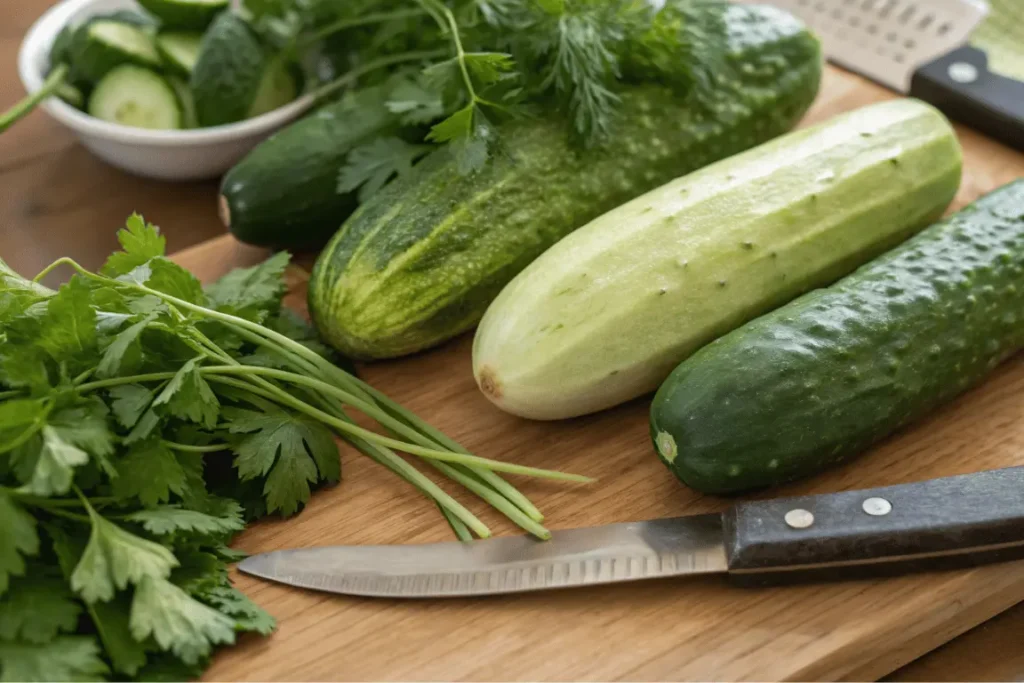
Not all cucumbers are created equal. The texture, flavor, and even water content of your cucumber can dramatically affect your salad’s outcome. Here are the best options for cucumber salad:
| Cucumber Type | Characteristics | Best Use |
|---|---|---|
| English Cucumbers | Thin skin, nearly seedless, mild | Ideal for raw salads |
| Persian Cucumbers | Crisp, small, sweet flavor | Perfect for bite-size dishes |
| Kirby Cucumbers | Crunchy, thicker skin, more seeds | Best for pickled cucumber salads |
| Garden Cucumbers | Thicker skin, more bitter if not peeled | Works best if seeded and peeled |
Tip: Always slice cucumbers thinly and evenly to maintain texture and absorb dressing better. For extra crunch, chill cucumbers before slicing.
If you’re working with extra watery cucumbers, lightly salt and drain them for 10 minutes before mixing. This trick prevents soggy salads and boosts flavor.
What Can You Put in Cucumber Salad? Creative Additions and Mix-ins
Cucumber salad is like a blank canvas—it welcomes all kinds of ingredients. Whether you’re craving bold, creamy, tangy, or spicy flavors, here are ideas that go far beyond the basics:
Fruits and Veggies That Work Well:
- Cherry tomatoes
- Avocados
- Red onions
- Bell peppers
- Watermelon cubes
- Corn kernels
- Sliced radishes
Protein Options:
- Crumbled feta or goat cheese
- Grilled shrimp or chicken
- Hard-boiled eggs
- Chickpeas or edamame
Nuts, Seeds & Crunchy Toppings:
- Toasted sesame seeds
- Crushed peanuts or almonds
- Croutons or crispy onions
Fresh Herbs for Maximum Flavor:
- Dill (a cucumber’s classic partner)
- Mint
- Basil
- Cilantro
- Chives
Dressings & Sauces:
- Greek yogurt and lemon
- Olive oil with balsamic vinegar
- Soy sauce with rice vinegar and sesame oil
- Mayo and mustard for a creamy twist
Looking for inspiration? Try our healthy ground turkey recipes—they pair beautifully with a crisp cucumber salad.
Don’t be afraid to experiment. As long as you maintain balance (something creamy, something acidic, something crunchy), your cucumber salad will be a winner every time.
The Secret Ingredient in Cucumber Salad
Every great cucumber salad recipe has that one secret ingredient—the unexpected twist that elevates it from simple to sensational. While cucumbers, vinegar, and salt form the foundation, adding just one magical component can transform your salad into something unforgettable.
What is the Secret Ingredient in Cucumber Salad? Popular Hidden Gems
There’s no one-size-fits-all answer here because “secret ingredients” vary depending on the style of cucumber salad you’re aiming for. However, here are some chef-approved options that often surprise and delight:
1. Sugar (Yes, Really!)
A small amount of sugar (about 1 tsp per cup of dressing) can help balance the acidity of vinegar or lemon juice and smooth out sharp flavors. It’s common in Southern-style cucumber salads and balances vinegar-based dressings beautifully.
2. Mustard Seeds
This spice adds a subtle crunch and depth of flavor that builds as it sits. Whole grain mustard also works well in creamy or tangy versions.
3. Fish Sauce or Anchovy Paste
Just a drop or two adds umami and complexity, especially in Asian-inspired cucumber salads.
4. Toasted Sesame Oil
This one’s a game-changer in Korean or Japanese cucumber salads. Its nutty, smoky aroma clings to the cucumbers and lingers on the palate.
5. Crumbled Feta or Blue Cheese
For a Greek or gourmet twist, feta adds a salty, creamy bite that enhances the coolness of cucumbers. Blue cheese creates bold contrast for creamy or peppery versions.
6. Freshly Grated Ginger or Garlic
Both add sharpness and vibrance. Ginger works beautifully in chilled salads, while garlic pairs perfectly with creamy and herbaceous flavors.
Don’t miss our flavorful idea with garlic butter noodles—a savory contrast to crisp cucumber sides.
Flavor Enhancers: Spices, Herbs, and Unexpected Additions
Even beyond secret ingredients, small additions can dramatically influence your salad’s profile:
| Flavor Profile | Recommended Additions |
|---|---|
| Tangy | Apple cider vinegar, rice vinegar, lime juice |
| Creamy | Sour cream, Greek yogurt, avocado |
| Spicy | Crushed red pepper, jalapeño, chili oil |
| Herbaceous | Dill, cilantro, parsley, mint |
| Sweet | Honey, maple syrup, thin orange slices |
These enhancers can help you customize your salad depending on the meal, season, or even your mood.
For example, add fresh dill and yogurt for a cooling summer salad, or go bold with chili oil, rice vinegar, and a hint of ginger for a fiery version that wakes up the palate.
Discover great ideas like this in our old bay seasoning shrimp salad recipe—it includes clever spice layering that complements cucumber beautifully.
How to Make Cucumber Salad Taste Better
Even a simple cucumber salad can go from average to amazing with just a few strategic tweaks. Whether you’re making a creamy version or something crisp and tangy, the secret is all in the technique and balance. Let’s uncover how to enhance flavor and texture like a pro.
Slicing Techniques That Impact Texture and Taste
Believe it or not, how you cut your cucumbers significantly affects the salad’s flavor absorption and crunch.
1. Thin Rounds or Half-Moons
- Best for quick pickling or light vinegar-based dressings.
- Maximizes surface area for flavor absorption.
- Use a mandoline slicer for consistency.
2. Thick Chunks or Spears
- Ideal when you want cucumbers to stay super crisp.
- Works well in salads where cucumbers are just one element of the mix.
3. Ribbon Style or Spiralized
- Great for plating and presentation.
- Absorbs dressing evenly while staying elegant and light.
Pro Tip: Lightly salt the slices and let them sit in a colander for 10–15 minutes. Then pat dry with paper towels. This step draws out excess moisture and intensifies flavor.
Balancing Sweet, Sour, and Crunchy
The most flavorful cucumber salads are all about contrast. To make the most of this, focus on three key flavor balances:
1. Sweet vs. Sour
Use ingredients like honey, sugar, or maple syrup to balance acidic components like vinegar or lemon juice. This creates a refreshing sweet-sour tang.
| Acidic Ingredients | Sweet Balancers |
|---|---|
| Apple cider vinegar | Honey |
| Rice vinegar | Sugar (white or raw) |
| Lemon/Lime juice | Agave or maple syrup |
2. Soft vs. Crunchy
Combine cucumbers with crisp vegetables (like red onions or radishes) and soft elements (like avocado or feta). This creates a layered mouthfeel that keeps each bite exciting.
3. Creamy vs. Zesty
For creamy cucumber salads, like the ones made with sour cream or yogurt, add zesty ingredients such as Dijon mustard, lemon zest, or horseradish to avoid a bland taste.
Looking for inspiration? Try our skillet cabbage rolls—a hearty, warm dish that pairs beautifully with a chilled cucumber salad.
Here’s a simple ratio to help you build a well-balanced dressing:
| Ingredient | Amount |
|---|---|
| Vinegar or Citrus | 2 tablespoons |
| Oil (olive, sesame) | 1 tablespoon |
| Sweetener | 1 teaspoon |
| Salt & Spices | To taste |
A good rule of thumb: always taste and adjust. Let your cucumbers marinate for 15–30 minutes before serving so the flavors can meld perfectly.
Cucumber Salad Styles from Around the World
Cucumber salad isn’t just a single recipe—it’s a global dish with regional variations that reflect local tastes and traditions. From Mediterranean freshness to Asian spice, let’s explore how cultures around the world reinvent this versatile salad in their own delicious ways.
What is a Greek Cucumber Salad? Traditional Greek Flavors
Greek cucumber salad, often referred to as Horiatiki, is a Mediterranean masterpiece. It features a vibrant combination of cucumbers, tomatoes, red onions, kalamata olives, and feta cheese, all dressed in extra virgin olive oil and sprinkled with oregano.
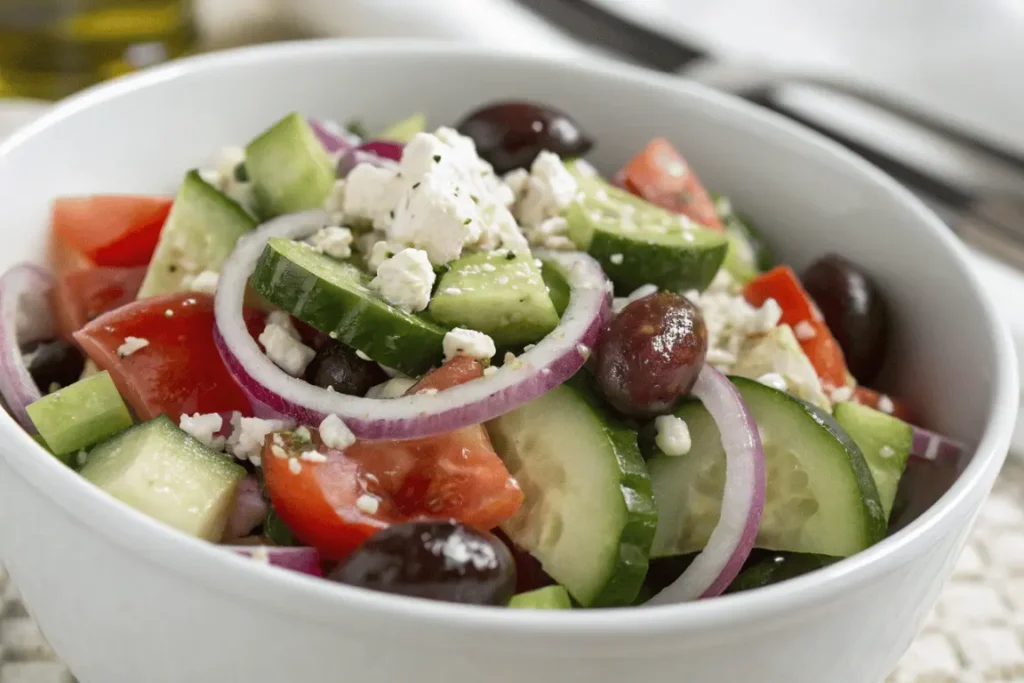
Key Ingredients:
- Thick-cut cucumber slices
- Ripe cherry or Roma tomatoes
- Thinly sliced red onions
- Pitted Kalamata olives
- Crumbled or block feta
- Olive oil, red wine vinegar, and dried oregano
Flavor Profile:
Tangy, salty, and herby, with a punch of Mediterranean sunshine in every bite. Unlike some creamy or sweet versions, Greek cucumber salad is all about freshness, acidity, and brine.
Pro Tip: Serve with a chunk of crusty bread to soak up the olive oil and juices left behind.
Check out our simple leche de tigre recipe—a zesty Peruvian marinade that’s similarly bold and citrusy.
Asian-Inspired Cucumber Salads: Sesame, Soy, and Chili Twists
In Asian cuisines, cucumber salad takes on spicier, tangier, and umami-rich profiles. These versions are often quick to prepare and served cold, making them ideal for hot weather meals.
Korean “Oi Muchim” (Spicy Cucumber Salad):
- Thin cucumber slices salted and drained
- Korean red chili flakes (gochugaru)
- Garlic, soy sauce, rice vinegar
- Toasted sesame oil and seeds
Japanese Cucumber Sunomono:
- Very thin cucumber rounds
- Rice vinegar, sugar, and salt
- Wakame seaweed (optional)
Thai-Style Cucumber Salad:
- Chopped cucumbers and red chilies
- Crushed peanuts, lime juice, fish sauce
- Fresh cilantro and mint
These salads are intensely flavorful thanks to the layering of sour, salty, spicy, and umami. They also tend to include bold garnishes and often double as palate cleansers during multi-course meals.
Don’t miss our fresh take on carnivore diet recipes—the richness of meat-based dishes benefits from a cool, vinegary cucumber salad on the side.
Whether you’re in the mood for something crisp and Mediterranean or bold and spicy, there’s a cucumber salad style out there to match. The best part? You can borrow ingredients and techniques from each to create your own fusion version.
What Should Not Be Mixed with Cucumber Salad?
While cucumber salad is one of the most flexible dishes around, not everything plays nicely with its cool, crisp nature. Some ingredients overpower cucumbers, clash with the texture, or even reduce shelf life. Let’s break down what to avoid to keep your cucumber salad light, refreshing, and delicious.
Ingredients That Clash with Cucumbers
1. Strongly Aged Cheeses
Cucumbers have a light, subtle flavor. Pungent cheeses like blue cheese or gorgonzola tend to overpower rather than complement. If you’re aiming for a cheesy note, go with mild feta or fresh mozzarella.
2. Overripe Fruits
Soft, juicy fruits like bananas or ripe pears release moisture and can turn your salad soggy and mushy quickly. Stick to firm, water-rich fruits like apples or watermelon if you want a fruity twist.
3. Cooked, Warm Ingredients
Cucumber salad is a cold dish by design. Adding hot, just-cooked ingredients like grilled chicken or sautéed mushrooms can wilt the cucumbers and create an off-putting texture. If you’re adding proteins, let them cool first.
4. Overly Acidic Ingredients
It may sound odd, but too much lemon juice, lime, or vinegar can actually break down the cucumber’s cellular structure, leading to a limp texture. Moderation is key.
5. Mayonnaise-Based Dressings + Acid
Creamy mayo doesn’t always hold up well when mixed with acidic ingredients like vinegar or lemon juice unless emulsified properly. The result? A split, watery dressing that doesn’t coat your ingredients evenly.
Learn more about smart pairing strategies from our raw vegan recipes—many of which emphasize balance and ingredient harmony, just like a good cucumber salad.
Storage Mistakes and How They Affect Flavor
Storage plays a big role in how your salad tastes an hour—or a day—after it’s made. Here are the top mistakes to avoid:
1. Dressing Too Early
Adding dressing too far in advance causes cucumbers to release water, watering down the flavor. Always add the dressing 15–30 minutes before serving.
2. Not Draining Cucumbers First
If you’re not salting and draining cucumbers, especially thicker varieties like garden cucumbers, you’ll end up with excess moisture in the bowl and a diluted dressing.
3. Using Metal Bowls
Acidic ingredients like vinegar can react with metal bowls, affecting both the taste and color. Stick to glass or ceramic for best results.
4. Storing in the Fridge Uncovered
Cucumber salad can absorb other odors in the fridge. Always store it in an airtight container to maintain its crisp, clean flavor.
Following these guidelines will ensure that your cucumber salad remains crunchy, flavorful, and vibrant—even if you make it a few hours ahead.
Healthy Benefits of Eating Cucumber Salad
Cucumber salad doesn’t just taste good—it’s good for you too. Packed with hydration, essential nutrients, and gut-friendly fiber, this refreshing dish is a nutritional powerhouse disguised as a simple side. Whether you’re watching calories, boosting hydration, or aiming for better digestion, cucumber salad has you covered.
Low-Calorie Nutrition Powerhouse
Cucumbers are made up of about 96% water, making them one of the most hydrating foods you can eat. They’re naturally low in calories, fat-free, and contain no cholesterol, which makes them perfect for anyone trying to maintain or lose weight.
Here’s a look at the nutrition profile of 1 cup of sliced cucumber (with skin):
| Nutrient | Amount |
|---|---|
| Calories | 16 |
| Carbohydrates | 4 g |
| Fiber | 1 g |
| Protein | 0.8 g |
| Vitamin K | 16% DV |
| Vitamin C | 4% DV |
| Potassium | 4% DV |
Add in a few extras like red onion, vinegar, or a dollop of yogurt, and you’ve got a dish that’s still under 100 calories—but bursting with flavor and health benefits.
Hydration, Digestion, and Skin Benefits
1. Improves Hydration
Because cucumbers are nearly all water, they help maintain optimal hydration—especially important in hot climates or during summer months. Hydration also supports energy, focus, and physical performance.
2. Supports Digestive Health
Cucumber salad often includes fiber-rich ingredients like onions, herbs, or even chickpeas. Fiber helps regulate bowel movements, prevent constipation, and support gut bacteria.
3. Promotes Clear Skin
Thanks to the water content and antioxidants like vitamin C and caffeic acid, cucumbers help reduce skin inflammation. Regular consumption may help with hydration at the cellular level, giving your skin a healthier glow.
4. Heart-Healthy and Anti-Inflammatory
Cucumbers contain potassium, which helps lower blood pressure. They’re also rich in antioxidants that can help fight inflammation—especially when paired with herbs like dill or parsley.
Don’t miss our nutritious twist in this carnivore diet ground beef recipe—a heavier meal that benefits from the refreshing contrast of a crisp cucumber salad.
Cucumber salad is more than just a tasty summer dish—it’s a simple, flavorful way to nourish your body with vitamins, hydration, and gut-friendly fiber every time you dig in.
Serving Ideas and Occasions for Cucumber Salad
Cucumber salad is a crowd-pleaser that fits seamlessly into nearly any meal or gathering. Its cool crunch and fresh flavor can refresh heavy entrees, complement grilled meats, or shine solo in lighter fare. Whether you’re hosting a summer BBQ or preparing a quick lunch, there’s a serving style perfect for the moment.
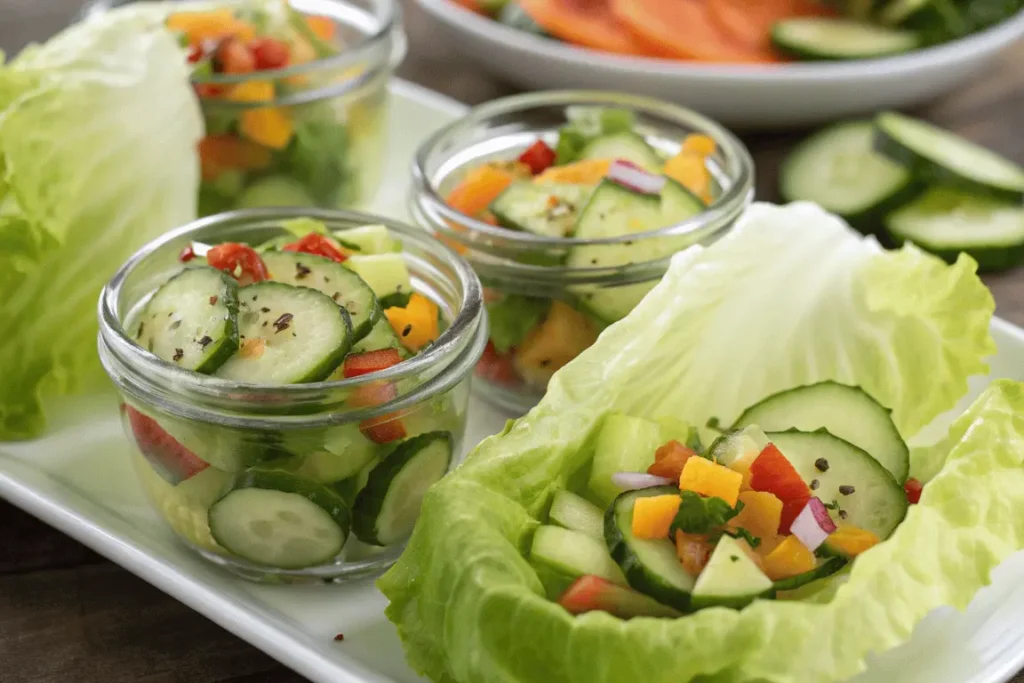
How to Plate Cucumber Salad for Any Meal
Plating cucumber salad creatively adds visual appeal and elevates the dining experience. Here are presentation ideas to match the vibe of the occasion:
1. Family-Style Platters
Ideal for picnics or potlucks. Use a wide, shallow bowl or platter so everyone can scoop easily. Garnish with lemon slices, fresh herbs, or crumbled cheese for a finishing touch.
2. Individual Jars or Cups
Perfect for picnics or on-the-go lunches. Serve cucumber salad in mason jars or small cups for easy grab-and-go portions that stay crisp and mess-free.
3. Elegant Stack or Ring Mold
Hosting a formal dinner? Use a metal ring mold to layer cucumber rounds with thin slices of red onion, avocado, or tomato. Drizzle with dressing just before serving.
4. Cucumber “Nests” on Lettuce Cups
Roll cucumber ribbons into a nest and serve them atop butter lettuce leaves. This adds texture and elevates simple ingredients with minimal effort.
5. Cucumber Salad Boats
Slice large cucumbers in half lengthwise, scoop out the center, and fill them with your salad mixture. It’s a fun, no-waste way to serve cucumber salad.
Pairings with Mains, Appetizers, and Drinks
Cucumber salad is so versatile it can act as a palate cleanser, a starter, or a robust side dish. Here are perfect pairings:
Main Course Pairings:
- Grilled Chicken or Fish: The cool crunch offsets the smoky, savory notes.
- Burgers and Sandwiches: Serve cucumber salad on the side or inside wraps.
- BBQ Ribs or Pulled Pork: Cucumber salad cuts through the richness of fatty meats.
- Asian Stir-Fries or Rice Dishes: The acidity complements umami-heavy meals.
Appetizers That Go Well:
- Hummus and pita
- Cheese boards with pickled veggies
- Deviled eggs or mini quiches
Drinks That Complement:
- Iced herbal teas (mint, lemon balm)
- Sparkling water with lime
- Dry white wines like Sauvignon Blanc
- Light, citrus-forward cocktails like mojitos
Check out this refreshing combo with best moose farts recipe—a sweet Canadian treat where cucumber salad offers a nice savory balance post-meal.
Whether you’re serving it as a starter or side, or even folding it into wraps or bowls, cucumber salad plays well with nearly any menu. Its flavor profile adapts to sweet, spicy, creamy, or sour pairings, making it one of the most flexible dishes you can prepare.
Expert Tips and Common Mistakes
Even though cucumber salad is simple to prepare, a few insider tricks can take it from basic to brilliant. At the same time, avoiding common missteps will ensure your salad stays crisp, flavorful, and fresh every time.
Chef-Level Advice for Perfect Results Every Time
1. Salt and Drain the Cucumbers
One of the best professional tips: salt your cucumber slices and let them sit in a colander for 10–15 minutes. Then, pat them dry with a paper towel. This removes excess water and prevents a watery dressing later.
2. Use a Mandoline for Uniform Slices
Consistent slicing isn’t just about looks—it ensures every piece absorbs the dressing evenly and maintains ideal texture. If you don’t have a mandoline, a sharp knife and steady hand will do.
3. Always Add Dressing Just Before Serving
Dress cucumber salad 15–30 minutes before you plan to eat it. Any earlier and the cucumbers may turn soggy or limp, especially with acidic dressings like vinegar or lemon juice.
4. Toast Spices and Seeds
To intensify flavor, lightly toast spices like mustard seeds or sesame seeds before adding them to the salad. This brings out their oils and boosts aromatic depth.
5. Taste as You Go
This may sound basic, but it’s vital. Cucumbers have subtle flavor variations based on variety, season, and freshness. Always taste your dressing and salad before serving and adjust salt, acid, or sweetness as needed.
Don’t miss our creamy recipe innovation in the easy chicken recipes justalittlebite style—a great dish to pair with cucumber salad for a flavor contrast.
Troubleshooting Common Cucumber Salad Issues
1. Why Is My Salad Watery?
This usually happens when cucumbers haven’t been salted and drained. It can also result from dressing too early or using overripe produce.
2. Why Does It Taste Bland?
You may need more acid (like lemon juice or vinegar), salt, or even a touch of sweetness. Add one at a time and retaste to balance the flavor.
3. Why Is My Dressing Separating?
Creamy dressings can split if made too far in advance or not emulsified well. Try blending ingredients thoroughly and whisking again just before tossing.
4. Why Do My Cucumbers Taste Bitter?
Some cucumbers, especially large garden varieties, can be bitter. Peel them fully and cut off the stem ends, which hold most of the bitterness.
5. Why Doesn’t It Keep Well?
Cucumber salad is best eaten fresh. If you need to store it, keep the cucumbers and dressing separate until just before serving. This helps retain the crunch.
By following these pro tips and staying mindful of common missteps, your cucumber salad can easily go from a quick fix to a show-stopping favorite.
FAQ Section
Q: What is the secret ingredient in cucumber salad?
The secret ingredient depends on the flavor profile you’re after, but many chefs swear by a touch of sugar to balance acidity or toasted sesame oil for nutty depth. Others rely on fresh dill, fish sauce, or even a spoonful of Greek yogurt to bring richness and complexity. For spicy versions, crushed red pepper or grated ginger is often the go-to. These “secret” additions elevate the flavor and add a unique twist.
Q: What can you put in cucumber salad?
You can put a wide variety of ingredients into cucumber salad, depending on your taste and the cuisine you’re mimicking. Some popular additions include:
– Red onions, for sharp contrast
– Cherry tomatoes, for sweet acidity
– Avocados, for creaminess
– Feta or goat cheese, for salt and richness
– Fresh herbs like dill, mint, or cilantro
– Crushed peanuts or sesame seeds for texture
– Simple dressings made with vinegar, oil, lemon juice, or yogurt
The key is to balance texture (crunchy vs. soft) and flavor (tangy vs. creamy).
Q: What should not be mixed with cucumber salad?
Avoid combining cucumber with:
– Soft, overripe fruits (they make the salad watery and mushy)
– Overly strong cheeses (like blue cheese, which overpowers)
– Hot ingredients (they wilt cucumbers)
– Too much acid (can break down cucumber structure)
– Unbalanced creamy dressings (can separate if not mixed properly)
Also, don’t forget to salt and drain cucumbers before mixing to prevent sogginess.
Q: What is a Greek cucumber salad?
Greek cucumber salad—also known as Horiatiki—is a classic Mediterranean dish made with:
– Thick cucumber slices
– Ripe tomatoes
– Sliced red onions
– Kalamata olives
– Crumbled feta
– Dried oregano
– Olive oil and red wine vinegar
It’s a non-lettuce salad focused on freshness, saltiness, and bold herbaceous flavor. Perfect as a side to grilled meats, seafood, or on its own with warm pita bread.
Conclusion: Final Thoughts on Crafting the Perfect Cucumber Salad
Cucumber salad is more than just a side—it’s a fresh, flavorful, and endlessly customizable dish that brings brightness and crunch to any table. From understanding your ingredient choices to exploring cultural variations and mastering technique, you now have all the tools to create a cucumber salad that’s balanced, beautiful, and bursting with flavor.
Whether you’re going for a quick weekday lunch or prepping a stunning side dish for guests, remember: the key is in the contrast—of textures, flavors, and temperatures.
Looking for inspiration? Try our bold and zesty natural mounjaro recipe—pairing it with cucumber salad adds a crisp, clean complement to rich, herbal notes.

